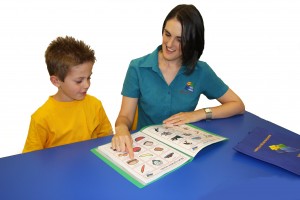
Children with speech or coordination problems are sometimes said to have “dyspraxia” but what does this mean and what can help?
Dyspraxia is defined as as “an impairment or immaturity of the organization of movement”. It is an immaturity in the way that the brain processes information, which results in messages not being properly or fully transmitted. It is considered a “specific learning disability” but it affects only specific skills and not all areas of development or learning.
Dyspraxia considered to be a neurologically based developmental disability which is present from birth. It affects motor planning. This means that although a child’s muscles are normal but the child cannot get their body to do what they want. There are three types of dyspraxia: oral, verbal and motor. A child with dyspraxia can have one or a combination of all three types of dyspraxia. Children with dyspraxia can appear the same as any other child until they have to perform a certain skill which they find difficult.
Dyspraxia is believed to be caused by an immaturity of parts of the brain that control movement which prevents messages from being properly transmitted to the muscles of the body. It is estimated that around 10% of children are affected with around 70% of these being boys. Dyspraxia does not affect children’s intelligence and children with dyspraxia can have normal or above average IQ. The difficulties experienced can have an impact on social skills and behaviour.
Oral dyspraxia affects planning and carrying out non speech movements such as blowing, sucking and making movements with the lips and tongue. It can affect eating, swallowing and managing saliva.
Some signs of oral dyspraxia include:
• Excessive drooling
• Dislike of certain textures of food
• Difficulty with movements such as blowing, sucking or licking
Verbal dyspraxia or Childhood Apraxia of Speech affects the control and coordination of movements for making speech sounds.
Children with verbal dyspraxia may show:
• Limited babbling and lack of variety in speech sounds in very young children
• Speech which is very difficult to understand
• Inconsistent speech patterns
• Difficulty sequencing sounds in words
• Use of “groping” or “searching” movements with the lips or tongue in an effort to make sounds or words
• Delayed expressive language skills, with more advanced receptive language skills
• Compensation for poor speech by communicating with gestures
• More difficulty in connected speech such as sentences or conversation than in single words
Motor dyspraxia affects the ability to plan, sequence and carry out movements to perform age appropriate skills in a smooth and coordinated way.
Children with Motor Dyspraxia may have difficulty with:
• Fine and gross motor skills
• Learning new skills and generalising these to other situations
• Coordinating movements and organising their body in space
• Handwriting
• Daily activities such as tying laces and doing up buttons
• Moving smoothly between steps in a task
Common questions
If I think my child has dyspraxia what should I do? Oral and verbal dyspraxia can be assessed and diagnosed by a speech pathologist who can then design and carry out a therapy program to help your child develop their speech skills. Occupational therapists can assess and treat motor dyspraxia and help chidlren develop skills such as handwriting and motor skills for daily living activities. For more information on speech and occuapational therapy assessments see Our website.
What types of treatment will help my child? A qualified therapist will help you by providing specifically designed activities to target the skills your child needs to work on in the correct sequence. They will also advise you about what to do at home to help your child. Generally early intervention is most effective and short regular practice of skills produces the best outcomes.
Will using an alterative form of communication help my child? Sometimes children have very limited speech or are very hard to understand and so an alternative communication system such as signing or picture exchange is recommended. Parents are often concerned that this will slow their child’s improvement but research has shown that this has a positive effect by reducing frustration and giving the child positive communication experiences. The child will replace the alternative system with speech when they are able. Your speech pathologist can help you use an alternative system with your child if this is appropriate.
Further information about speech and occupational therapy is available on Our website.
General information about dyspraxia can be found athttp://www.dyspraxia.com.au/
Related Blog Posts
If you liked this post you may also like:
What is ADD and ADHD?
More sound awareness
Say it first!
Accessing NDIA for children over 6 years



